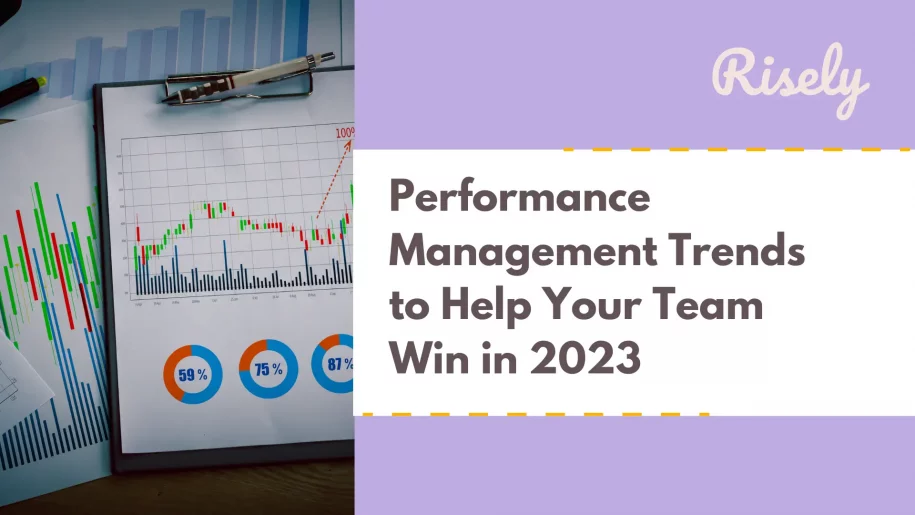Performance Management Trends to Help Your Team Win in 2023
The world of work is rapidly changing, as are employee performance expectations. The traditional annual performance review is no longer enough to keep up with the pace of change, and companies need to embrace new trends in performance management to remain competitive. In this blog, we will take you through the evolution of performance management and highlight the latest trends shaping how we evaluate employee performance. We cover everything from real-time feedback to data-driven metrics and leveraging AI for better insights. We also provide tips on effectively implementing these trends in your organization. So buckle up and prepare to take your team’s performance to new heights in 2023!The Evolution of Performance Management: A Historical Review
Performance management has undergone significant changes throughout history, adapting to the ever-evolving dynamics of the workplace. Traditionally, it revolved around annual reviews, but modern trends now emphasize real-time feedback and continuous improvement. This shift is driven by the necessity for more effective ways to measure and enhance employee performance. Moreover, new performance management practices aim to address biases, improve employee engagement and development, and create a better employee experience. It’s essential to take a closer look at the historical evolution of performance management to understand its impact on organizations and employees.The Latest Performance Management Trends: A Brief Overview
The latest performance management trends prioritize employee development and training, emphasizing continuous feedback and coaching for improved performance outcomes. These trends leverage data-driven performance metrics to provide insights for informed decision-making and drive performance improvements. Additionally, AI technology enhances performance management processes by enabling personalized development plans. By adopting these top performance management trends, organizations can create a holistic approach that considers their employees’ personal context and well-being.Emphasis on Employee Development & Training
Employee development and training are critical components of the latest performance management trends. These trends recognize the importance of providing professional growth and learning opportunities to enhance employee engagement and retention. Organizations can drive better performance outcomes by creating personalized development plans based on individual strengths and areas for improvement. Coaching and mentoring programs further support employee development and align with organizational goals. Continuous learning and upskilling are vital for sustained success in a rapidly changing business landscape.Real-Time Performance Management
Real-time performance management empowers organizations to provide timely feedback and make necessary course corrections. Regular check-ins and ongoing communication foster continuous improvement and development, boosting employee engagement. Managers can promptly address performance issues and recognize achievements in real time, enhancing employee morale. Leveraging technology tools like performance management software and mobile apps facilitates seamless real-time communication. Embracing this top-performance management trend allows organizations to stay agile and responsive in today’s dynamic business landscape.Data-Driven Performance Metrics
Data-driven performance metrics offer objective insights into employee performance. HR leaders can leverage analytics and measurement tools to make informed decisions and identify areas for improvement. These metrics help identify high performers, address performance gaps, and support talent management strategies. It’s crucial to align performance metrics with the organization’s goals, incorporating qualitative and quantitative measures. Regular analysis of performance data enables proactive interventions and adjustments. By utilizing data-driven performance metrics, organizations can take a closer look at their employees’ opportunities for growth and development.Leveraging AI for Performance Management Improvements
In today’s fast-paced and data-driven world, leveraging AI for performance management can significantly improve your team’s success. By automating processes, AI technology enhances efficiency and frees up valuable time for human resources. AI-powered performance management systems go beyond traditional approaches by providing personalized recommendations for employee development, considering factors such as professional development goals and personalization. With the help of natural language processing, feedback and performance data are analyzed, leading to actionable insights that drive performance improvements. AI algorithms also play a crucial role in identifying patterns and trends in performance data, empowering HR leaders to make strategic decisions that align with organizational goals. With AI, performance management becomes more objective, reducing biases and ensuring fair evaluations. Wondering how it works? Find an example here: Becoming The Best Manager: Why AI Co-Pilot Overtakes Manual Solutions?OtherInterestingReads
Focus on Inclusion & Diversity in Performance Metrics
As performance management trends evolve, there is a growing emphasis on measuring inclusion and diversity. HR leaders now incorporate diversity metrics to ensure fair evaluations and promote a more inclusive workplace. By leveraging analytics, workplace biases can be identified and addressed, creating an environment that considers diverse employees’ unique strengths and challenges. Prioritizing diversity in performance metrics fosters a more inclusive workplace and improves employee engagement.The Impact of Remote & Hybrid Work on Performance Management
Remote and hybrid work models are driving new performance management trends. Adapting performance reviews to manage remote teams effectively is crucial. Real-time communication tools and performance management systems are vital in overseeing remote employees. Performance feedback should be tailored to consider remote or hybrid work’s unique circumstances and challenges. The shift towards remote work has increased the demand for performance management software. These changes in work structure require organizations to rethink and adjust their performance management strategies.Questioning Traditional Performance Metrics
As HR professionals continue to reevaluate traditional performance metrics, there is a growing recognition that more objective measures can replace biases and subjective judgments in annual reviews. One of the top performance management trends is the shift towards regular check-ins and real-time feedback, allowing for a more personalized and user-friendly approach. Data-driven decisions replace gut feelings in performance evaluations, leading to more accurate employee performance assessments. These new ways of measuring performance take a closer look at individual goals, personal development, and alignment with the organization’s objectives.Tips for Implementing Performance Management Trends
To successfully implement performance management trends, it is crucial to have a clear understanding of the organization’s goals and objectives. Human resources professionals can leverage technology and automation to streamline performance management processes, making them more efficient and effective. Regular check-ins and real-time communication between managers and employees are essential for fostering a culture of performance improvement. Personalized and tailored performance feedback based on individual employees’ needs can help drive motivation and growth. Finally, data-driven decisions using employee performance data can improve outcomes and align with the organization’s goals.Setting SMART Goals and Objectives
Setting specific, measurable, achievable, relevant, and time-bound (SMART) goals and objectives is crucial to performance management. These goals provide employees with clarity and direction, helping to drive their performance. Employees can track their progress and make necessary adjustments by setting clear expectations and milestones. It’s essential to involve employees in goal-setting, aligning their individual goals with the team and organizational objectives. Regularly reviewing and adjusting goals allows for flexibility and adaptation to changing circumstances.Encouraging Continual Feedback and Dialogue
Creating an open communication and trust culture is critical to encouraging continual feedback and dialogue. Regular feedback sessions provide opportunities for coaching and development conversations, fostering employee growth. Encouraging employees to share their perspectives and ideas enhances collaboration and innovation, driving better results. Constructive, specific, and actionable feedback is essential to improving performance. Managers should actively listen and show empathy, understanding their direct reports’ unique challenges and needs. Organizations can foster a culture of growth and professional development by prioritizing continual feedback and dialogue.Aligning Individual and Team Goals with Organizational Strategy
Aligning individual and team goals with the organization’s strategy is crucial for achieving business objectives. By clearly communicating the goals, employees can understand their role in the overall success. Performance management systems are essential to cascading goals from top to bottom, ensuring alignment at all levels. Regular check-ins and progress updates help managers provide guidance based on organizational priorities. Celebrating milestones reinforces the connection between individual and team performance and the organization’s success. Find some more resources here: Questions To Ask And Never Ask : A Comprehensive Guide On Performance ReviewsConclusion
In conclusion, staying abreast of the latest performance management trends is crucial for helping your team thrive in 2023. Emphasizing employee development and training, implementing real-time performance management, and leveraging data-driven performance metrics are key trends to consider. Additionally, incorporating AI technology, prioritizing inclusion and diversity in performance metrics, and adapting to the impact of remote and hybrid work are important factors to keep in mind. To successfully implement these trends, it’s essential to set SMART goals, encourage continual feedback and dialogue, and align individual and team goals with your organization’s strategy. By embracing these performance management trends, you can empower your team to achieve success and reach new heights in the coming year.Performance blues hitting hard? Leverage feedback to set things right
Take the free constructive feedback assessment for managers to ensure higher effectiveness in your team.
Other Related Blogs
How Can You Build A High Performing Culture? 7 Hacks
How Can You Build A High Performing Culture? 7 Hacks We have all heard of dream teams and tried to build them with varying levels of success and failure. Among…
10 Effective Manager Performance Goals to Drive Team Success
10 Effective Manager Performance Goals to Drive Team Success You’re sitting across from a manager in a performance review meeting. They seem unsure, disconnected from the company’s vision, and oblivious…
How to Build a High-Performing Team?
How to Build a High-Performing Team? Creating a high-performing team is a goal that every organization aspires to achieve. A high-performing team achieves superior results and can quickly adapt to…
How Culturro Developed Effective Performance Reviews – A Lookback
How Culturro Developed Effective Performance Reviews – A Lookback Performance management – is often a dreaded phrase, and not without valid reasons to back that fear. We often conflate performance…


